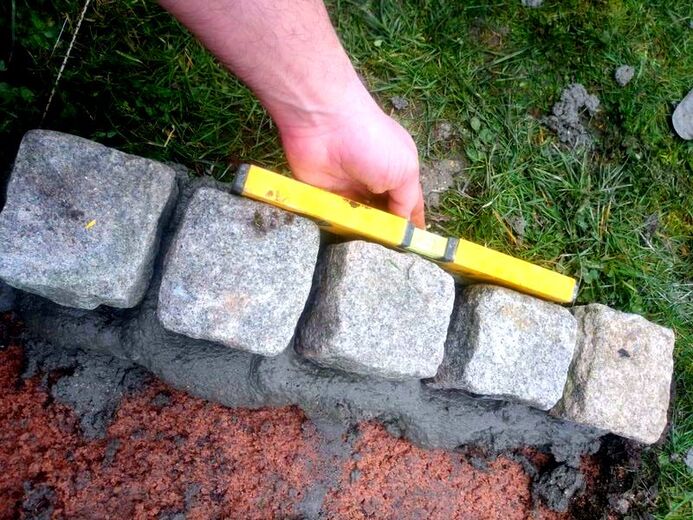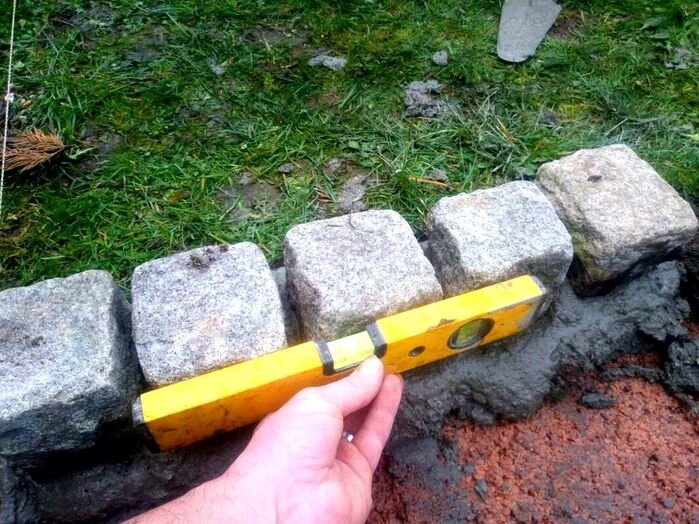|
This article contains affiliate links
Granite sets are an extremely aesthetic and durable building material. Made up of crystallised, igneous rocks, granite setts have incredible compressive strength and weather resistance.
Their speckled appearance is dotted with shades of black, pinks and greys. These, fine, visual, textures have led them to become a favoured and common sight in external construction. The most traditional use for granite sets was surfacing the streets or towns. This was before the widespread adoption of tarmac. In my early career we would regularly uncover hundreds of metres of granite setts covered over with tarmac. Due to their timeless charm and indestructibility there is a high demand for reclaimed granite setts. However, there are also many suppliers who now also stock new granite setts. Here, I will answer common granite sett questions as well as how to lay granite setts correctly. What is the difference between cobbles and granite setts?There is some debate on if there is actually any difference between cobbles or setts at all. The word cobble typically refers to large circular stones found around mountainous coasts. As a general rule setts are square and cobbles are rounded. Old streets laid with granite setts are often referred to as ‘cobbled streets’ This is because the individual granite sets have formed into more circular, dome, shapes over time.
The continuous action of vehicles, foot fall, horses and carriages have smoothed down the setts angular edges and wearing surface.
If you wish to replicate a 'cobble effect' you will need to use reclaimed granite setts from a road. However, it is also fair to say that new setts will also create a cobble effect surface. The difference is new sets with have a more rough texture and angular surface. Can you lay setts on sand?
Granite setts are a robust building material and need to be laid on a strong mortar mix. Sand on its own will not be strong enough to hold granite sets in position. How many granite setts in a square metre?
If you are using the most common type of granite sett (100mm x 100mm square) you will need about 85 setts per square meter.
Are granite setts slippery?
Some reclaimed sets from roads with heavy traffic have smooth and rounded surfaces. These do have the potential to be slightly slippery if re-laid. However, these can be laid with an alternative side facing upwards. Alternatively, you can purchase new granite sets with a more textured and angular surface. What is the best mortar mix to lay granite setts?
The best mortar mix to lay granite setts is one which uses course or sharp sand. These have fine enough particles to make the mortar workable to bed the units into position. At the same time the particles are coarse enough that heavy setts do not sink and displace. The best mortar mix for setts is 1 part cement and 4 parts sharp sand. Plasticiser should be added for extra workability and the mix should not be too wet. Sett laying mortar should be just wet enough to create a suction seal around the unit. However, the mix should be stiff enough to hold the sett level and firmly in position. For the easiest laying experience create a consistent and level sub-base beneath your setts. You should aim for a mortar thickness of around 15-25mm under your setts. How much does it cost to lay granite setts?
To lay an extensive surface area with granite setts is a labour intensive and expensive method of surfacing. This is because granite setts themselves are much more expensive per metre than other paving materials. Add to this each unit has to be individually bedded down, levelled and grouted. I have worked out you could expect to pay around £450.00 per square metre for granite sett surfacing.
This would include excavation, disposal of spoil, installing a sub-base, laying the setts and grouting the setts.
For laying single granite sett edgings expect to pay about £55.00 per linear metre. Again this would include all excavation, preparation, laying and grouting. How to lay granite setts step by stepBelow I have included a step by step guide on how to lay granite setts with pictures. Before starting your project you may wish to visit our article on the best tools for paving here.
Step 1
Work out the finished level of your new granite setts. The best way to do this is with a tight string line to realise a consistent gradient. This level can then be pegged out so you know much you need to excavate.
Step 2
Excavate out the area where you wish to lay your setts to a depth of 180mm. Make sure the excavation is consistent and square with no loose soil present. The best way to get rid of excavated soil is in a skip. Why not read our article on how to fill a skip with soil here.
Step 3
Supply and spread an 100mm layer of mot type 1 to the base of the excavation and compact well.
Step 4.
Mix up 1 part cement to 4 parts sharp sand in a cement mixer with some water and plasticiser. Mix well until the mortar reaches a stiff bricklaying mix.
Step 5.
Set up a string line so you can lay your first row of granite sets perfectly straight and level.
Step 6.
One at a time bed down your granite sets on to the mortar taking care to keep them flush and level.
Step 7.
As you lay check your level and alignment with a spirit level.
Step 7.
Haunch any exterior or edging setts with a triangular fillet of mortar to lock them into position.
Step 8.
Mix up a 1 part cement 3 part plastering sand mortar mix dry until it is well mixed. Slowly add a little water until it is damp but not wet. You should be able to just form a ball with the mix inside your hand. The grouting mortar should be just damp enough to work a good finish but not wet enough to smear.
Step 9.
Grout your granite setts by packing in mortar tightly between the units. Then, using a jointing iron or hose pipe, work the joints to a smooth and consistent finish. When the grout has been jointed gently brush off excess grout with a very soft brush. The best brush for this is an old and dry paint brush.
You have now completed laying your granite setts! If you require landscaping services requiring laying granite setts do not hesitate to contact us.
Below we have included some other landscaping articles you may find useful.
'As an Amazon associate I earn from qualifying purchases'
0 Comments
Leave a Reply. |
The Author
|
Landscaping services across Buckinghamshire, Amersham, Aylesbury & High Wycombe
Hyde Heath, Amersham, Buckinghamshire |
|























